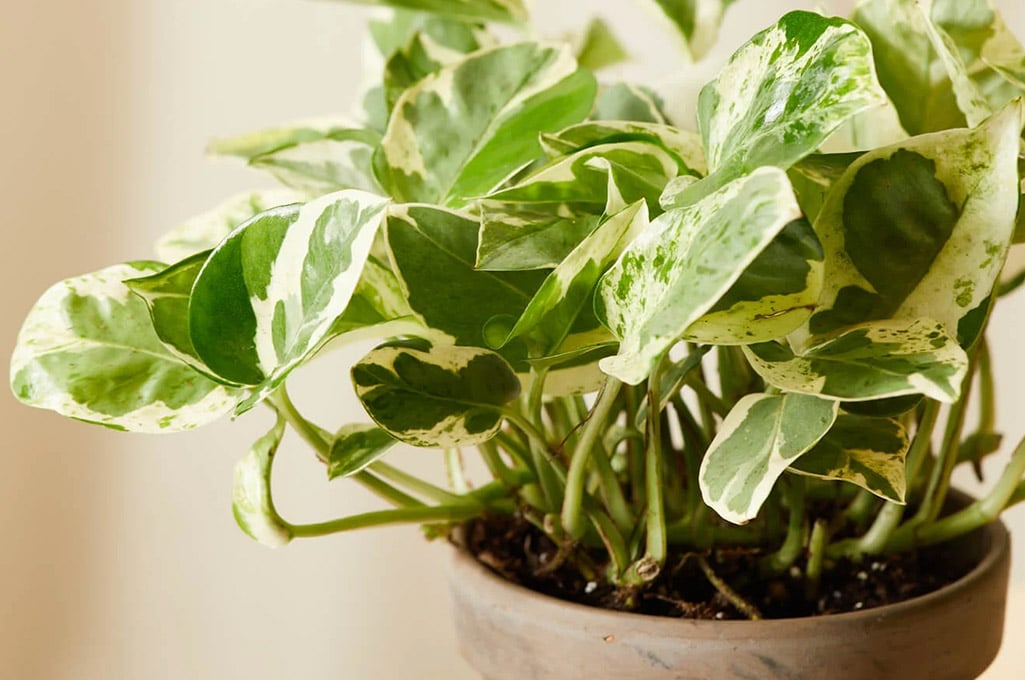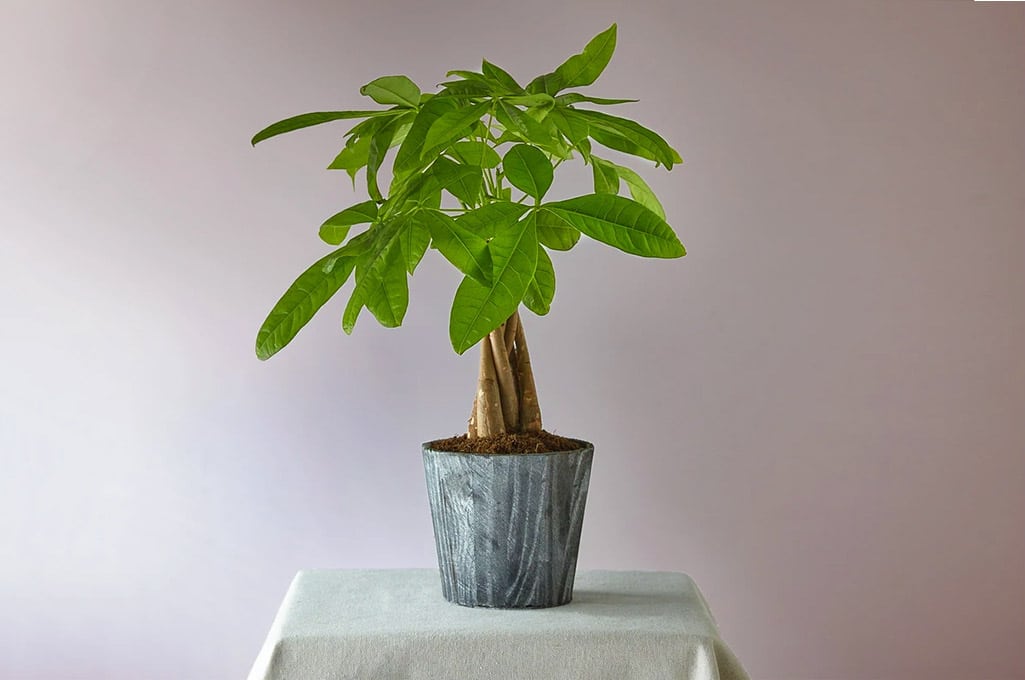Pictured above: Devil’s Vine from Bloomscape
So you want to enjoy being a plant parent. Who wouldn’t? Houseplants help replenish the oxygen in your home, help you concentrate, increase positive vibes, plus, they’re just nice to look at. But what if you weren’t blessed with a green thumb? What if you were instead blessed with the plant equivalent of the reverse Midas touch? Every plant you touch dies.
Don’t worry. We’ve got you covered. When looking for a plant that can conquer your thumb of death, you’ll want to look for foliage that doesn’t need direct sunlight, likes being indoors, and most importantly, can deal with being neglected. Here are 15 houseplants that are pretty much immortal. Like vampires.

Spider plant (Chlorophytum comosum)
Keeping with the spooky theme, spider plants kind of look like green spiders. Except they don’t eat bugs. These plants resemble decorative grass and have a nice cascading presence when placed in a hanging planter. Because they’re originally from Southern Africa, spider plants are incredibly resilient in hot and dry environments and require very little watering. They do best in bright indirect sunlight and are safe for pets and tiny humans. The best part is that they’re super easy to propagate. So you can create a whole army of them all over your house.

Pothos (Epipremnum aureum)
Also called Devil’s Vine (another ominous sounding plant), Pothos plants have heart-shaped leaves and come in a variety of green and yellow hues. So why the diabolical sounding name? Because this vine is practically indestructible. You can starve it of light, and it will still maintain its bright, healthy color. These natives of Southeast Asia thrive in locations where they can just do what vines do best: hang (away from pets and prying hands). What’s even more impressive is that they can survive in only water. Can you say supernatural foliage?

Snake plant (Dracaena trifasciata)
The Snake plant, also known as Saint George’s Sword and Mother-in-Law’s Tongue (cringe) get its name from its pointy leaf structure. These elongated plants are native to tropical western Africa and have variations of white or yellow markings set against dark green foliage. They can grow up to three feet tall, and like real snakes, are not pet friendly. Like some in-laws, these plants thrive on neglect, so you won’t see them getting wilted and dramatic if you forget to water them or expose them to copious amounts of fluorescent lighting (insert mother-in-law joke here).

Philodendrons (Philodendron Sp.)
These tropical American plants symbolize health and abundance, and are great at filtering pollutants from the air. Philodendron actually means “love tree” in Greek, so it’s bizarre that it’s actually toxic. There are over 450 varieties, most of which start their lives as vines and then morph into epiphytes (grow on trees). Philos put up with low light, but their true M.O. is bright, indirect filtered sunshine. They only need a drink every one to two weeks, so remember not to over water, because no one likes a soggy bottom.

Aloe (Aloe)
Aloe vera is best known as a cool, lime green gel that you rub on yourself after you’ve over-baked in the sun. There are actually over 550 different kinds of aloe in the world, and most of them look absolutely amazing in a tiny pot on your desk. These succulents hail from North Africa and Southern Europe, and only need watering every two to three weeks during the warm months. That being said, aloes need bright, indirect sunlight or else they get really leggy. So just realize that if you hide it in a dark corner behind your couch, it will eventually look like you’re harboring a giant octopus in your home.

Zebra Hawthoria (Haworthiopsis attenuata)
Here’s another virtually immortal succulent from South Africa. Its color pattern is akin to green and white zebra stripes. Pair that with it’s spiked leaves, and it looks like something straight out of a Tim Burton movie. But don’t worry, these little guys are non-toxic. They need watering every couple of weeks and do best in partial sunlight. If they start to turn red, that means they’re getting stressed out from too much sun. If your zebra plant turns white, that means you’ve somehow managed to kill an indestructible Tim Burton plant.

Chinese Evergreen (Aglaonema)
Symbolizing luck and good fortune, Chinese Evergreens are considered the perfect housewarming gift because they’re virtually maintenance free. The only hitch is that they’re toxic. Aglaonema blooms flowers that resemble lilies, but they’re more commonly praised for their brightly colored leaves. Originally from the tropics and subtropics of Asia, these hardy plants enjoy medium to low sunlight and warm and moderately humid temperatures. They are low-key plants that will tolerate less than ideal environments, however they won’t put up with your shenanigans.

Flaming Katy (Kalanchoe blossfeldiana)
Beautiful, but toxic, this is one houseplant that you’ll want to keep away from people, pets, and probably kids. That being said, this Madagascan native blooms small white, yellow, orange, pink, or red flowers every six months. For care, Katy only likes a drink when her soil is dry, and she prefers to sunbathe in bright light. Ultimately, she’s a pretty lady with simple pleasures who happens to have a flair for danger. She didn’t ask to be like that, she was just born that way.

Money tree (Pachira aquatica)
The most prominent money symbol for feng shui enthusiasts, these plants actually come from Central and South America. They’re commonly seen interwoven together and are usually spotted in the south-east corner of a room (that’s the universal money corner, if you were wondering). Money trees do great in bright to medium sunlight and are safe around pets. When it comes to watering, this one is a glugger and needs a good drink one to two times a week. Potting it in a container with drainage holes is necessary to prevent potential root rot, because the last thing you want to do is kill your money tree. That would be terrible for your Chi.

Umbrella Tree (Schefflera arboricola)
The Schefflera wants you to leave it alone, so it can do its own thing. So moody. It wants you to follow the no nonsense care approach: Park it in bright, indirect light, make sure that the soil is dry before you water it, and keep it away from pets and prying fingers because, yes, it’s toxic. This native of Taiwan can actually produce flowers at the proper temperature and humidity level (so, not indoors). Its blooms are bright red and look like tentacles. Maybe that’s why it’s also called the Octopus Tree.

ZZ Plant (Zamioculcas zamiifolia)
Not to be confused with ZZ Top, the ZZ Plant is also known as the “Eternity Plant” because it’s believed to have immortality. Like the Pothos, this South African native can survive for months without sunlight and water. The kicker is that ZZ will stay ZZing and won’t start growing until it finds sunlight, water, possibly some positive affirmations and good tunes. It likes low light and needs watering once the soil is dry. It’s also toxic, and unlike the ZZ Plant (and ZZ Top), you are not immortal and cannot live forever, so don’t tempt fate.

Purple Shamrock (Oxalis triangularis)
If you don’t believe in the power of the houseplant, then this South American native will change your mind. In addition to its purple plumage, this little shrub actually moves right before your eyes. You’ll know when it’s uncomfortable because it will slowly open and close its leaves depending on the amount of light it’s exposed to. It enjoys bright, indoor light, biweekly watering, a well-draining pot, and long walks on the beach. It’s magical to look at, but not if you eat it. So look, but don’t eat.

Cactus (Cactaceae)
This Plantae has something for everyone. These thorny guys are mainly native to the Americas and come from two types of climates: desert and forest. The desert cacti like bright light, minimal watering (once or twice a month), and should never ever be put on the ground because that’s how injuries happen. The forest variety prefer bright, filtered sunlight with a similar watering pattern. While these succulents are non-toxic, it’s probably not a good idea to have them in low-lying areas that Spot or Mr. Whiskers have easy access to.

Jelly Bean/Pork and Bean (Sedum rubrotinctum)
The small, oval-shaped leaves of this Mexico native look like greenish-red candies (or kidney beans), hence the names. This hardy succulent takes minimal watering and thrives in partial to full sunlight. It’s super easy to propagate and “loses” its leaves frequently, meaning any movement will knock off nubbins, which is great if you’re planning on creating a whole room full of Jelly Bean plants. So depending on how you’re feeling, this little succulent could be a sweet or salty visual addition to your home.

Elephant Bush (Portulacaria afra)
What’s non-toxic, drought tolerant, fire-resistant, and sucks carbon from the air like a kid with a McFlurry on a hot summer day? This cact-guy. It looks like a mini jade plant and is super easy to propagate–just snip it, stick it in soil, and let it do its thing. It’s a succulent from South Africa and, when left unhindered, can grow upwards of fifteen feet. It’s also literally a nomnom source for elephants (i.e. a non-toxic lunch). Portulacaria enjoys full to partial sun and would look super cute if you decorated it with mini Christmas ornaments.